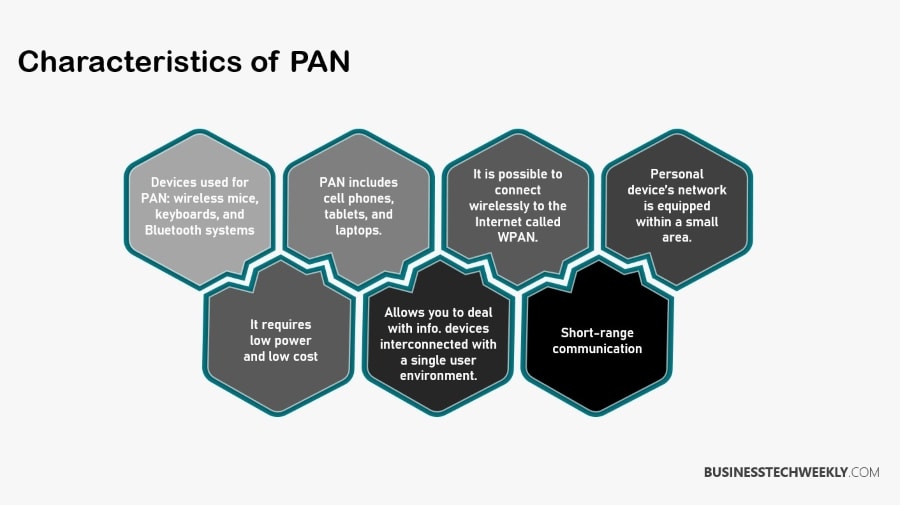What is a Personal Area Network (PAN)?

As devices get smaller with technological advancements, there is a greater need to facilitate communication between various devices to share data and resources. Personal Area Networks (PAN) provide the needed short-range connection of devices for communication and data transfer to address this need.
Below, we explain what is a personal area network (PAN), and take a look at some of the advantages and disadvantages these types of networks have to offer.
On this page:
What is a Personal Area Network?
A Personal Area Network (PAN) is a data network that connects electronic devices within the immediate range of the user. The network range for a PAN is generally up to 10 meters.
The interconnected devices may include cellphones, laptops, computers, PDAs, printers, keyboards, and other entertainment devices like game consoles, speakers, or wearable gadgets belonging to a user.
A PAN can connect devices with or without wires. Such a network could also be connected to the internet or other networks.
A Personal Area Network provides a single user environment to connect multiple devices. This type of network is quite useful in offices, homes, and other small network areas because of its exceptional performance in terms of efficiency and flexibility.
It is a low-cost network system that facilitates small area communication, mainly covering personal devices. A PAN is often set up for resource sharing and communication between devices like wireless mouse and keyboard, TV remotes, smartphones, gaming consoles, Bluetooth, wireless USB, wireless printers, and more.
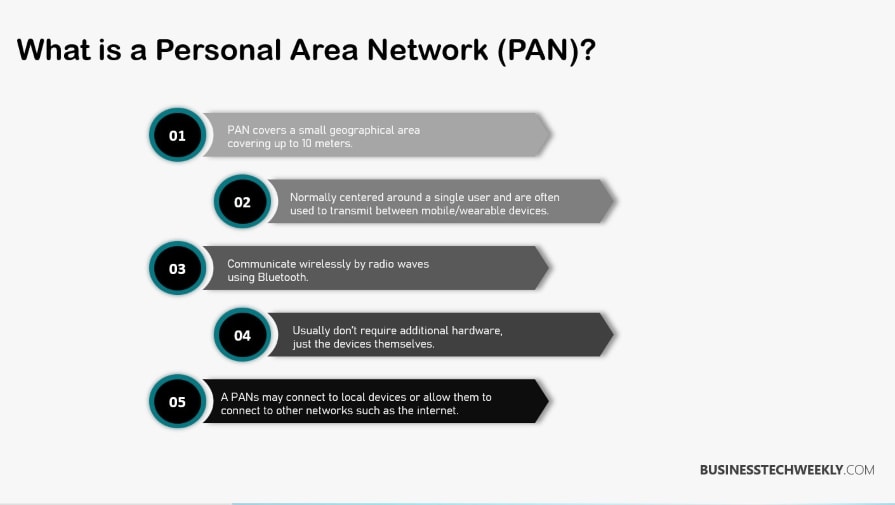
Types of Personal Area Networks
A PAN network might be wireless or wired. USBs and FireWire are frequently required for connecting a wired PAN.
On the other hand, PAN often uses Bluetooth or, in some cases, infrared connections. In theory, a PAN might be made up of small, wearable, or embedded devices that communicate with other wireless devices when they come into contact with them.
Wired PAN
Personal Area Networks connected through wires is called a Wired PAN. Such a network is connected through wires/cables like Universal Serial Bus (USB) or Firewire.
Wireless PAN
Wireless Personal Area Network (WPAN) uses wireless technology like Bluetooth, Infrared, Ultra-wideband, and ZigBee to connect devices. Today, most PANs found in everyday applications are wireless based on close-range wireless connectivity like Bluetooth.
See also: Understanding Wireless Networks
The wireless PAN range is generally small because it uses short-range wireless protocols that lose their efficiency over distances greater than 5-10 meters.
Some of the technologies used in WPANs are:
- Bluetooth – Based on the idea of embedding a low-cost transceiver chip in each gadget, allowing wireless equipment to be synchronized entirely without the user having to initiate any action. The chips would communicate at up to 2 Mbps on a previously unused radiofrequency. Bluetooth’s overarching purpose may be characterized as providing pervasive connectivity between personal technology equipment without wiring usage.
- W-PANs with high data rates – According to IEEE 802.15 TG3, released in 2003, these technologies require greater power (8 dBm) than typical Bluetooth equipment (0 dBm) to broadcast data at up to 55 Mbps and above a range of up to 55 m.
- W-PANs with low power – According to IEEE 802.15 TG4, these technologies are especially beneficial for handheld hardware because the energy consumption and expenses for data transmission are exceptionally low. The operational range of up to 75 m is greater than that of current Bluetooth applications. However, the data transfer rate is limited (250 Kbps)
- ZigBee – Zigbee is a short-range, low-power computer networking technology. ZigBee products in the United States operate in the unlicensed bands 902-928 MHz and 2.4 GHz. The technology is designed to be simpler and less expensive than existing WPANs, such as Bluetooth. Even though ZigBee is a WPAN protocol, it is also utilized for telemetry applications such as building automation and automated meter reading.
You can learn more about ZigBee here
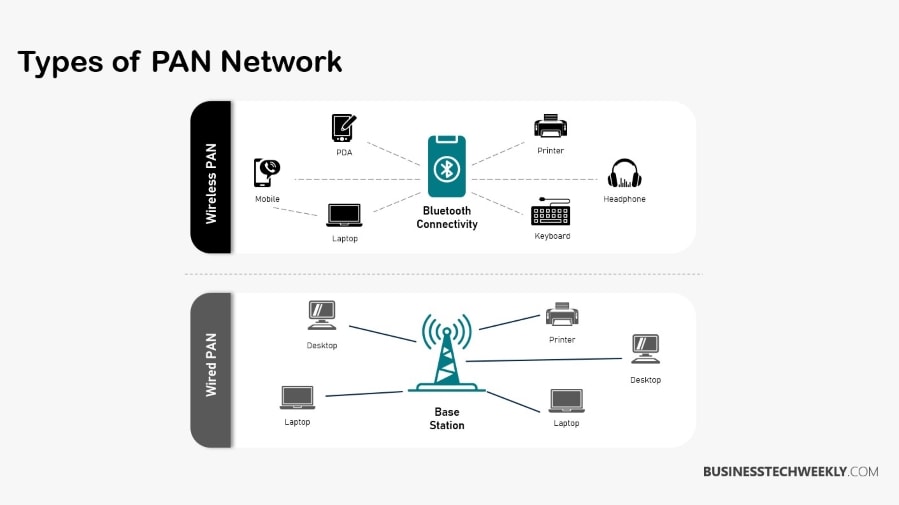
What is a Personal Area Network used for?
A Personal Area Network has several uses and applications. Let us try to understand the purpose of this network with the help of some real-life examples.
Body Area Network
A mobile network moving with a person is an example of a Personal Area Network. The person may establish a network connection between his smartphone and his Bluetooth headphone. The network travels wherever the person goes. This is called a body area network.
Small Home Office
A home office is usually set up using a small network separate from the home network. This type of Personal Area Network works as an entity with multiple pieces of equipment interconnected for everyday tasks related to the office.
Offline Network
In this type of personal area network, such as PCs, printers, data storage, speakers, mouse, and other appliances are integrated without connecting to the internet. These equipment use Wi-Fi, Bluetooth, or other wireless technology to connect. An offline communication network is created between the pieces of equipment within a small area like a home or office.
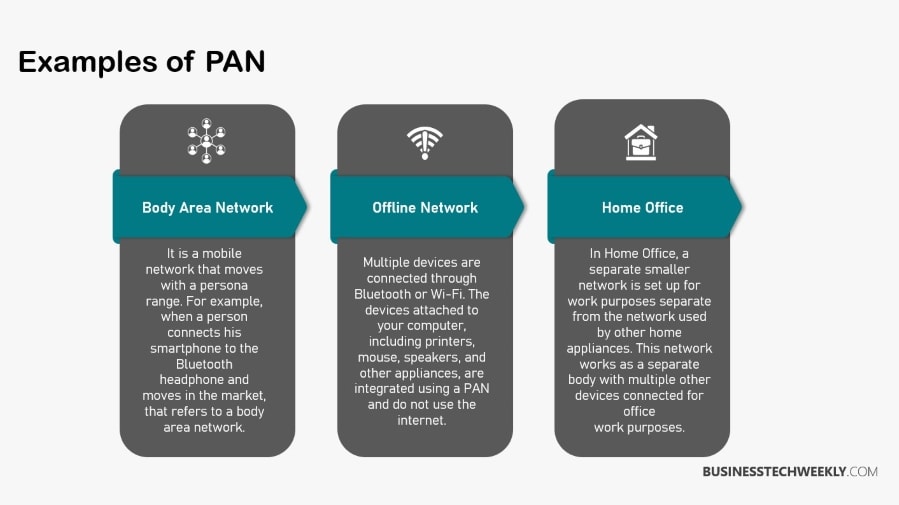
Advantages & Disadvantages of PANs
Personal Area Networks allow users to connect multiple pieces of equipment for easy and reliable transmission of data. Apart from personal use, they have several benefits and applications.
Advantages
Some of the most significant benefits of personal area networks are:
Data protection – A personal area network is generally more secure than other networks since the interconnected endpoints have sought permission from the authorized user before transmitting data between them.
Cost-effective – A PAN network does not require any complicated setup or cable connection between devices, making it more cost-effective than other networks.
Easy to use and maintain – This type of network has no advanced configuration requirements to be used efficiently. Moreover, as it involves no complexities of wires, servers, and routers, it is also easy to maintain. If any problem occurs on the network, it can be easily handled.
Space-saving – A PAN uses Bluetooth or other technology to directly share data between connected devices, allowing storage to be shared, and taking up minimal physical space.
Stability and reliability – As the network does not depend on servers and operates within a short range, it is more reliable and stable than more extensive networks.
Concurrent multiple connections – In a personal area network, a device can be connected to multiple devices simultaneously. For example, a smartphone can connect concurrently with several tablets and mobile phones.
Disadvantages
Personal Area Networks also have some limitations like:
Slow data transmission – Technology like Bluetooth cannot transmit considerable amounts of data between multiple devices at high speeds, so PANs are generally slower than other types of networks like WAN, LAN, and MAN.
Limited area – This type of network can transmit data within a short range of about 10 meters. The network is also limited to a few devices connected.
Interference with radio signals – Data transmitted through a personal area network is prone to loss as it can interfere with radio signals in the range.
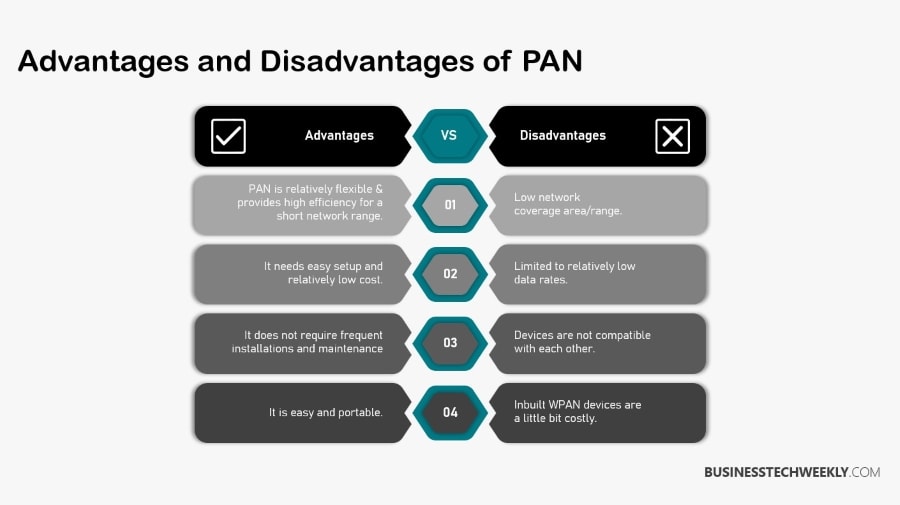
Personal Area Network Vulnerabilities
To safeguard your Personal Area Network (PAN), you must first understand the risks and security challenges of this sort of network.
Personal area networks differ from Local Area Networks in that they often function outside of the Local Area Network environment yet are connected to it.
Since Personal Area Networks are often segregated, a normal vulnerability scan of the local network may miss vulnerabilities within the PAN.
A PAN may contain numerous types of user equipment, each of which has a security risk that might be exploited by a cybercriminal (hacker) to breach the PAN and then employ lateral techniques to get access to the rest of the network.
A PAN provides advantages, but it also introduces potential security weaknesses. The principal vulnerabilities of a personal area network are as follows:
- Location Privacy — When a cellphone is part of the Personal Area Network, there is the risk that an attacker may eavesdrop on the Bluetooth packets, obtaining the device’s hardware address. This compromises the user’s identity and can be used to track their position.
- Vulnerabilities in Utilized Devices – Internet of Things (IoT) devices used in networks may be vulnerable. IoT hardware are popular targets for hackers because they are simple to exploit. Security features and authentication systems are frequently deficient. In addition, when a new vulnerability is uncovered, manufacturers fail to deliver security patches.
- Bluesnarfing – The use of Bluetooth to steal information from a device. With the right equipment, hackers can take data from as far away as 300 feet. This type of crime is frequently committed in public places such as coffee shops and libraries. Hackers can acquire access to all of your phone’s information and even initiate calls that rack up phone bills.
